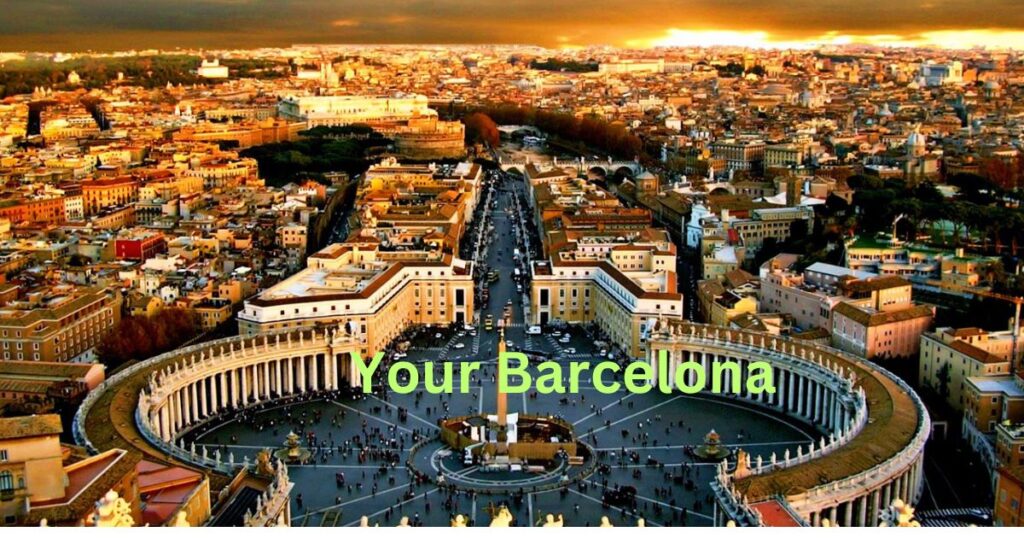Introduction-
Picture yourself strolling down a sunlit boulevard, the scent of fresh paella wafting from a nearby café, while the whimsical spires of a Gaudí masterpiece pierce the sky. This is Barcelona, Spain—a city where Mediterranean charm meets avant-garde flair, and every corner hums with life. As the capital of Catalonia, Barcelona continues to captivate the world, welcoming millions of visitors who come to experience its unique blend of art, culture, and coastal beauty. In this travelogue, I’ll guide you through its irresistible allure, share expert insights from my travels, and ignite your wanderlust for a city that’s as vibrant as it is timeless—perfect for anyone dreaming of exploring this Catalan gem.
The Allure of Barcelona: The City of Contrasts
Barcelona’s magic lies in its ability to blend opposites seamlessly. Nestled on Spain’s northeastern coast, this cosmopolitan metropolis pulses with contradictions that somehow create perfect harmony. Ancient Roman walls stand in the shadow of soaring modernist towers. Gothic cathedrals share streets with Gaudí’s dreamlike structures. Peaceful beaches meet bustling urban energy. It’s a city that refuses to be just one thing—and that’s precisely its charm.
What makes Barcelona stand out isn’t simply the sights, though they’re extraordinary. It’s the spirit—the fierce Catalan pride that colors everything from the language you’ll hear on the streets to the traditional sardana dances in plaza squares. The city’s architectural legacy, thanks largely to Antoni Gaudí, redefines what buildings can be. His Sagrada Família doesn’t just sit in the city; it seems to grow from it, organic and alive, still under construction after 143 years.
Barcelona offers authenticity over tourist traps, though you’ll need to look beyond Las Ramblas to find it. Here, you can sip vermouth with locals in a hidden bodega, discover neighborhood markets where vendors have served the same families for generations, or stumble upon a jazz concert in a medieval courtyard. This cultural richness feels rare and raw—a living city that hasn’t sacrificed its soul to tourism, despite welcoming the world to its shores.
A Traveller’s Journey: Exploring Barcelona’s Soul
Arrival: First Impressions
Landing at Barcelona-El Prat Airport, just 12 km from the city center, you’re immediately struck by how accessible everything feels. The metro system offers the most economical route downtown via Line 9 Sud, with a dedicated airport ticket costing €5.70 for the roughly 30-minute journey to the heart of Barcelona. For those planning multiple days of exploration, the Hola Barcelona Travel Card provides unlimited public transport access—including airport transfers—for consecutive periods of 2, 3, 4, or 5 days, making it an excellent value for active travelers.
Stepping out onto the streets for the first time, you’ll feel Barcelona’s particular energy—less frantic than Madrid, more cosmopolitan than Seville. The light here has a golden quality that makes everything look like it’s being painted in real-time. Street performers command corners with acrobatics and music, while vendors selling fresh flowers add splashes of color to every major thoroughfare.
Key Highlights
Natural Wonders
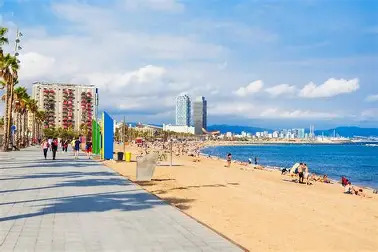
Barcelona’s beaches stretch 4.5 km along the coast, from the popular Barceloneta to the modern Port Fòrum area. While man-made and redeveloped for the 1992 Olympics, these beaches offer an authentic Mediterranean experience—locals swim here year-round, play beach volleyball at sunset, and gather at chiringuitos (beach bars) for cold drinks and grilled seafood. The water is swimmable from May through October, with summer temperatures reaching a comfortable 25°C (77°F).
Montjuïc Hill
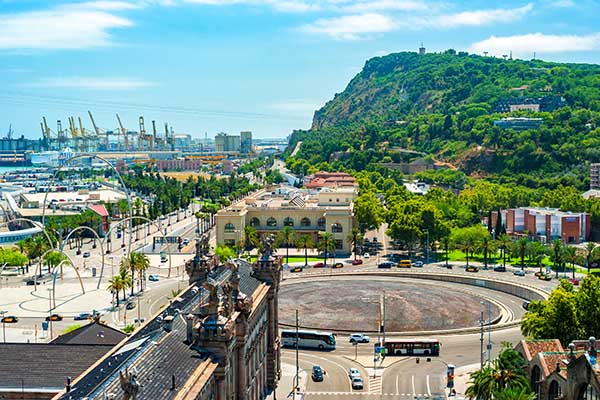
Beyond the shore, Montjuïc Hill rises 173 meters above the harbor, offering panoramic city views and lush gardens that feel worlds away from the urban energy below. The hill hosts the Montjuïc Castle, Olympic Stadium, and stunning botanical gardens.
Montjuïc Cable Car
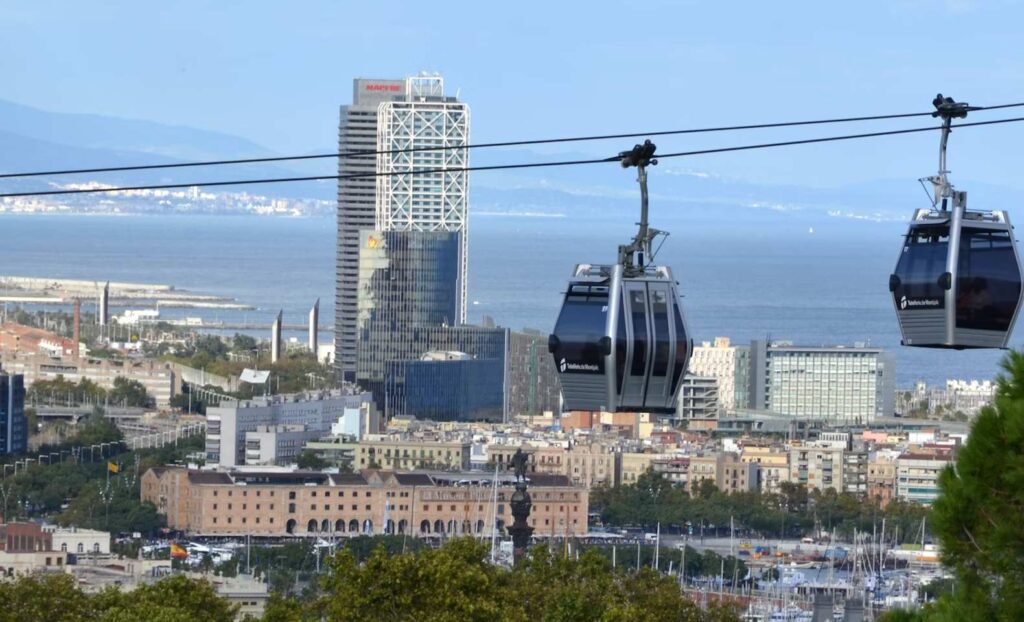
Reach the summit via the Montjuïc Cable Car (Telefèric de Montjuïc), which provides breathtaking aerial views of the city and coastline. For a different perspective, try the Port Cable Car (Transbordador Aeri) connecting Barceloneta to Montjuïc—a thrilling ride suspended over the harbor.
Cultural Gems
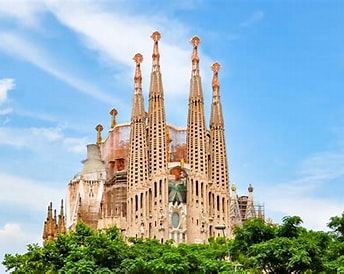
The Sagrada Família remains Barcelona’s crown jewel—Gaudí’s unfinished masterpiece that continues to evolve. This UNESCO World Heritage Site now welcomes visitors with tickets starting at €26 for basic admission with an audio guide app, while tickets including tower access begin at €36. Book well in advance, as this is one of Europe’s most visited monuments. The interplay of light through the stained glass windows transforms the interior into a kaleidoscope of color—visit around mid-morning for the most dramatic effect.
The Gothic Quarter (Barri Gòtic) unfolds like a medieval labyrinth, its narrow stone streets hiding centuries of history. The Barcelona Cathedral, a stunning example of Catalan Gothic architecture, welcomes visitors free of charge outside of mass hours, though a small donation is appreciated. Wander these lanes without a map—getting lost here is half the fun. You’ll discover hidden plazas where locals sip coffee at century-old cafés, artisan workshops tucked into ground-floor alcoves, and remnants of Roman walls integrated into modern buildings.
La Boqueria Market
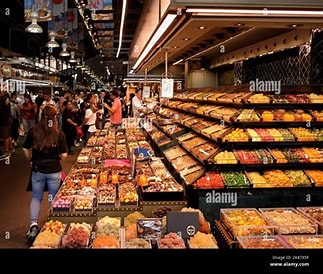
La Boqueria Market, just off Las Ramblas, assaults your senses in the best possible way. Over 300 stalls burst with vibrant produce, fresh seafood glistening on ice, cured meats hanging from hooks, and exotic fruits you’ve never seen. Arrive early before the tourist crowds, grab a spot at one of the tapas bars in the back, and enjoy freshly prepared dishes using ingredients purchased mere steps away. The market has served Barcelona since 1217, and that continuity is palpable.
Don’t miss Casa Batlló and Casa Milà (La Pedrera), two more Gaudí masterpieces along Passeig de Gràcia. Casa Batlló’s undulating façade seems to ripple like water, while Casa Milà’s rooftop with its surreal chimney sculptures offers both art and stunning city views. Both require timed-entry tickets, best purchased online in advance.
Hidden Spots
Escape the crowds at the Church of Santa Maria del Mar, a serene masterpiece of Catalan Gothic architecture built by medieval merchants and sailors in the 14th century. Its soaring interior achieves an ethereal quality with minimal decoration—the architecture itself is the art. Visit during the late afternoon when golden light filters through the rose window, and you might catch the sound of a choir rehearsing.
The Bunkers del Carmel
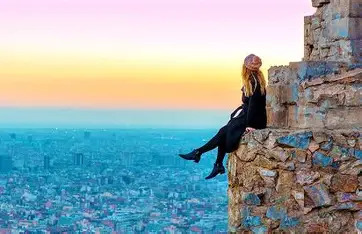
The Bunkers del Carmel remain Barcelona’s best-kept secret for sunset views. These abandoned anti-aircraft bunkers from the Spanish Civil War sit atop Turó de la Rovira, offering 360-degree views of the entire city—from the Mediterranean to the mountains, from the Sagrada Família to the Torre Agbar. It’s free to access, though the climb up winding streets requires decent fitness. Bring snacks and drinks, arrive before sunset, and watch Barcelona transform from day to night as lights begin twinkling across the urban landscape below.
The neighborhood of Gràcia
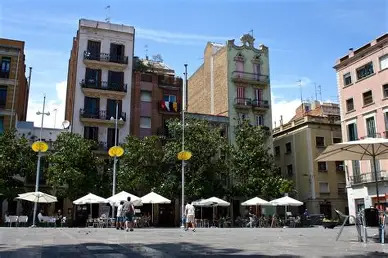
For a taste of local life, explore the neighborhood of Gràcia, Barcelona’s bohemian heart. This former village maintains its own distinct identity, with charming plazas connected by narrow streets, independent boutiques, vintage shops, and cozy bars where locals far outnumber tourists. August brings the Festa Major de Gràcia, when residents transform their streets with elaborate decorations competing for the best-dressed street award—a tradition that draws locals from across the city.
Expert Tips for Your Visit
Timing Your Trip: Spring (April through June) offers ideal conditions—mild temperatures averaging 15-22°C (59-72°F), fewer crowds than summer, and special events like Sant Jordi on April 23rd, when Catalans exchange books and roses in a celebration of Catalan culture. Fall (September-October) provides similar benefits with the added bonus of the La Mercè festival in late September.
Avoid July and August if possible—Barcelona swelters in summer heat (often exceeding 30°C/86°F), beaches become packed, and many locals flee the city for vacation. However, if summer is your only option, embrace it: Barcelona practically moves to the beach, with beach clubs and chiringuitos creating a festival atmosphere.
Navigating Like a Local: Purchase a T-Casual card (10 metro/bus journeys for approximately €12) if you’re staying several days and not using the Hola Barcelona card. Download the TMB app for real-time public transport information. Remember that Barcelona is incredibly walkable—some of the best discoveries happen on foot between major attractions.
Dining Strategies: Eat on Spanish time. Lunch runs from 2:00-4:00 PM, dinner starts around 9:00 PM or later. Tourist-trap restaurants line Las Ramblas—walk two blocks in any direction for better food at half the price. Look for places where locals eat: they’ll often have a menú del día (daily menu) offering three courses plus wine for €12-18.
Language Considerations: While many Barcelona residents speak English, learning a few Catalan phrases will earn smiles. Try “Bon dia” (good day), “Gràcies” (thank you), and “Si us plau” (please). Catalan pride is real—showing respect for the language and culture goes a long way.
The Emotional Pull: Why Barcelona Resonates
Barcelona doesn’t just dazzle with architecture and beaches—it seeps into your soul. Standing in Parc Güell, surrounded by Gaudí’s mosaic-covered serpentine benches and fantastical structures, you feel transported to a place where imagination has no limits. The park was designed as a garden city, a utopian vision that never fully materialized but left behind something perhaps more valuable—a reminder that cities can be both functional and magical.
Later, sharing tapas at a centuries-old bodega with a local who recounts tales of Catalan resistance and pride, you understand why Barcelona feels different from other Spanish cities. This is a place that has fought to maintain its identity, language, and culture. That resilience creates an authenticity you can feel in every conversation, every neighborhood festival, every defiant use of Catalan instead of Castilian Spanish.
The city speaks to everyone differently. Art lovers find revelation at the Picasso Museum (housing over 4,000 works from the artist’s formative years) or the contemporary MACBA. Food enthusiasts discover worlds of flavor, from traditional pa amb tomàquet (bread with tomato) to avant-garde molecular gastronomy at Michelin-starred restaurants. Adventurers can scale Tibidabo Mountain via the historic funicular railway or cycle the beachfront promenade. History buffs can trace 2,000 years from Roman ruins to medieval quarters to modernist boulevards.
Tibidabo Mountain
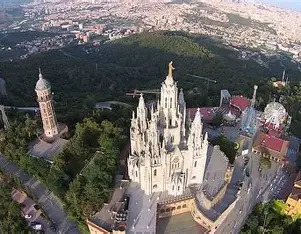
What unites all these experiences is the feeling Barcelona gives you—lighter somehow, as if the Mediterranean breeze carries your cares away and replaces them with possibility. It’s not just a trip; it’s a revelation that cities can balance history with innovation, beauty with grit, tradition with progress.
Practical Magic: Planning Your Barcelona Adventure
Getting There
By Air: Barcelona-El Prat Airport (BCN) connects to cities worldwide, with terminals T1 and T2 serving different airlines. From the airport:
- Metro Line 9 Sud: €5.70 airport ticket, approximately 30 minutes to city center
- RENFE train: €5.05 to Sants Estació or Passeig de Gràcia, every 30 minutes
- Taxi: Fixed rate of €30-35 to city center (more expensive late night and weekends)
- Aerobús shuttle: Connects airport to Plaça Catalunya in 35 minutes
By Train: High-speed AVE trains connect Barcelona-Sants Station to Madrid in just 2.5 hours, with prices ranging from €40-100 depending on booking time and class. The station also serves destinations throughout Spain and international routes to France.
Where to Stay
Example: This grid-like district designed by Ildefons Cerdà houses most of Gaudí’s masterpieces. Wide streets, elegant architecture, and excellent restaurants make it ideal for first-time visitors. Mid-range hotels run €120-200 per night.
Gothic Quarter: Stay in the historic heart for maximum atmosphere. Winding medieval streets, ancient churches, and proximity to Las Ramblas appeal to history lovers. Budget hostels start around €30-50 per night for dorms, while boutique hotels in restored buildings range €150-300.
Gràcia: For a more local, bohemian experience, this neighborhood offers charming plazas, independent shops, and authentic tapas bars. Generally more affordable than central Barcelona, with vacation rentals and small hotels from €80-150 nightly.
Barceloneta: Beach lovers should consider this neighborhood, with direct beach access and seafood restaurants. Can be noisy in summer but offers a distinctive coastal atmosphere. Hotels and apartments range €100-250 per night.
What to Pack
Comfortable walking shoes are non-negotiable—Barcelona’s charm reveals itself on foot, and you’ll walk miles daily over cobblestones and up hills. Pack layers: evenings can be cool even in summer, especially near the water. Sunscreen and sunglasses are essential year-round—the Mediterranean sun is powerful. Bring a light jacket for spring and fall, a reusable water bottle (tap water is safe and tastes fine), and a small day pack for beach days and market visits.
Budget Insights
Barcelona can accommodate various budgets with some planning:
Budget travelers (€50-70 daily): Stay in hostels, eat at local bars and markets (excellent bocadillos for €4-6, menú del día €12-15), use public transport, visit free attractions (beaches, Bunkers del Carmel, Gothic Quarter wandering), and enjoy affordable museums on free days.
Mid-range travelers (€100-150 daily): Stay in modest hotels or vacation rentals, mix restaurant meals with market eating, take occasional taxis, visit major paid attractions, and enjoy vermouth or cocktails at neighborhood bars.
Luxury travelers (€250+ daily): Stay in boutique hotels or upscale accommodations, dine at renowned restaurants, use taxis and private transfers, skip lines with premium tickets, and enjoy rooftop bars and beach clubs.
The Hola Barcelona Travel Card provides excellent value for active travelers: 48 hours costs approximately €17, while 5 days runs about €38—substantial savings compared to individual tickets, and it includes airport transfers.
Cultural Etiquette
- Meals are social events, not quick refueling. Expect lunch to last 1.5-2 hours, dinner even longer.
- Tipping isn’t mandatory but rounding up or leaving 5-10% for good service is appreciated.
- Many shops and businesses close for siesta (roughly 2:00-5:00 PM), though tourist areas stay open.
- Be aware of the political sensitivity around Catalan independence. Listen more than you opine.
- Dress reasonably when visiting churches—covered shoulders and knees show respect.
Visual Inspiration: A Feast for the Eyes
Imagine the Sagrada Família’s spires glowing amber at dusk, their stained glass windows transforming the interior into a cathedral of color.
Las Ramblas
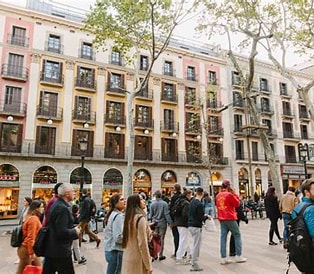
Picture Las Ramblas in early morning before the crowds arrive—flower vendors arranging their stalls, the mosaic pavement still wet from overnight cleaning, the promise of the day ahead palpable in the air.
Envision Casa Batlló’s undulating façade, its balconies like skeletal masks, its surface seeming to ripple with organic life. See Parc Güell’s candy-colored mosaic tiles catching the light, Gaudí’s serpentine bench winding through the terrace like a Mediterranean dragon. Feel the contrast of the Gothic Quarter’s shadowy medieval alleys suddenly opening onto sunlit plazas where ancient stones have been worn smooth by countless footsteps.
Barcelona rewards visual attention. The details matter here—the ironwork on a balcony, the tiles lining a storefront, the way light hits a particular building at sunset. This is a city designed to be seen, appreciated, photographed, and remembered. Bring your camera and your curiosity in equal measure.
The Call to Adventure: Your Barcelona Awaits
Barcelona isn’t just a destination on a map—it’s a feeling that settles in your chest, a collection of moments that become memories you’ll revisit for years. It’s the taste of perfectly ripe tomatoes at La Boqueria, the gasp when you first see the Sagrada Família’s interior, the unexpected connection with a local who shares their favorite neighborhood haunt, the simple pleasure of sunset from the Bunkers with new friends from around the world.
Don’t let Barcelona remain a dream on your bucket list. Start planning now. Research flights, compare accommodation options, make lists of must-see sights and must-try dishes. Barcelona has a way of exceeding expectations because it offers something for everyone while maintaining its fierce, proud identity.
The city is ready for you. The question is: are you ready for Barcelona?
Insider’s Edge: Local Secrets
Calçotada

Seek out calçots between January and March—these grilled spring onions served with romesco sauce represent a beloved Catalan tradition called calçotada. You’ll eat them with your hands, getting messy in the best possible way, often at restaurants outside the city in the countryside where locals gather for hours-long feasts. Can Travi Nou in the Collserola hills offers an authentic experience.
For sustainability-conscious travelers, shop at local markets like Santa Caterina Market (with its stunning colorful wavy roof) rather than supermarkets. Support artisans in the Gothic Quarter and Gràcia rather than souvenir shops. Consider renting bicycles through the city’s Bicing system or taking walking tours with local guides who know hidden corners and authentic stories.
Try a vermut (vermouth) at a traditional bar like Morro Fi or La Vermuteria del Tano—this aperitif enjoyed before lunch is a Barcelona tradition that predates the cocktail craze. Served on tap with an olive or twist of orange, accompanied by potato chips or olives, it’s how locals socialize before the midday meal.
“Cuisine of Barcelona”
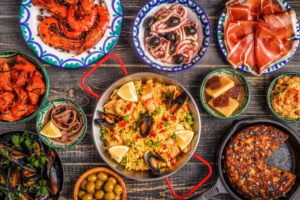
Visit the Mercat de Sant Antoni, recently renovated, on Sunday mornings when it hosts a book and vintage market where locals browse and bargain. The neighborhood around it offers authentic bars and restaurants frequented primarily by Barcelona residents.
Conclusion: A City that Changes You
After your Barcelona journey ends and you’re on the plane home, something will feel different. Maybe it’s the way you think about cities—that they can prioritize beauty alongside function, that public spaces can be gathering points for community rather than just thoroughfares. Maybe it’s a renewed appreciation for distinct regional culture and identity in an increasingly homogenized world. Maybe it’s simply the joy of having connected with a place that challenged you, delighted you, and ultimately changed you.
Barcelona has this effect on people. It’s why so many visitors become repeat visitors, why some never leave at all. The city gets under your skin with its combination of accessibility and mystery, its blend of world-famous attractions and neighborhood secrets waiting to be discovered.
You’ll catch yourself comparing other cities to Barcelona—finding them wanting in one way or another. The light isn’t quite right. The food lacks that particular freshness. The architecture feels less daring. The streets don’t have that same energy. This isn’t nostalgia; it’s recognition that you’ve found a place that resonates with something essential in yourself.
So when you find yourself daydreaming about narrow Gothic lanes or the peculiar beauty of modernist architecture, when you crave patatas bravas or vermouth at a sidewalk table, when you remember the feeling of Barcelona’s Mediterranean breeze on your face—that’s Barcelona calling you back. And like everyone who’s fallen under its spell, you’ll find yourself planning your return before you’ve even fully unpacked.
Barcelona doesn’t just offer a vacation. It offers transformation, inspiration, and proof that cities can be works of art where people actually live, love, work, and create. It’s waiting for you—that sunlit boulevard, that whimsical spire, that perfect moment when everything aligns and you think, “Yes. This is exactly where I’m meant to be.”
Sources:
For official tourism information, detailed itineraries, and booking assistance, visit spain.info, the official tourism website of Spain. For Barcelona-specific information, check Barcelona Tourism and the Sagrada Família official website for tickets and tour information.

